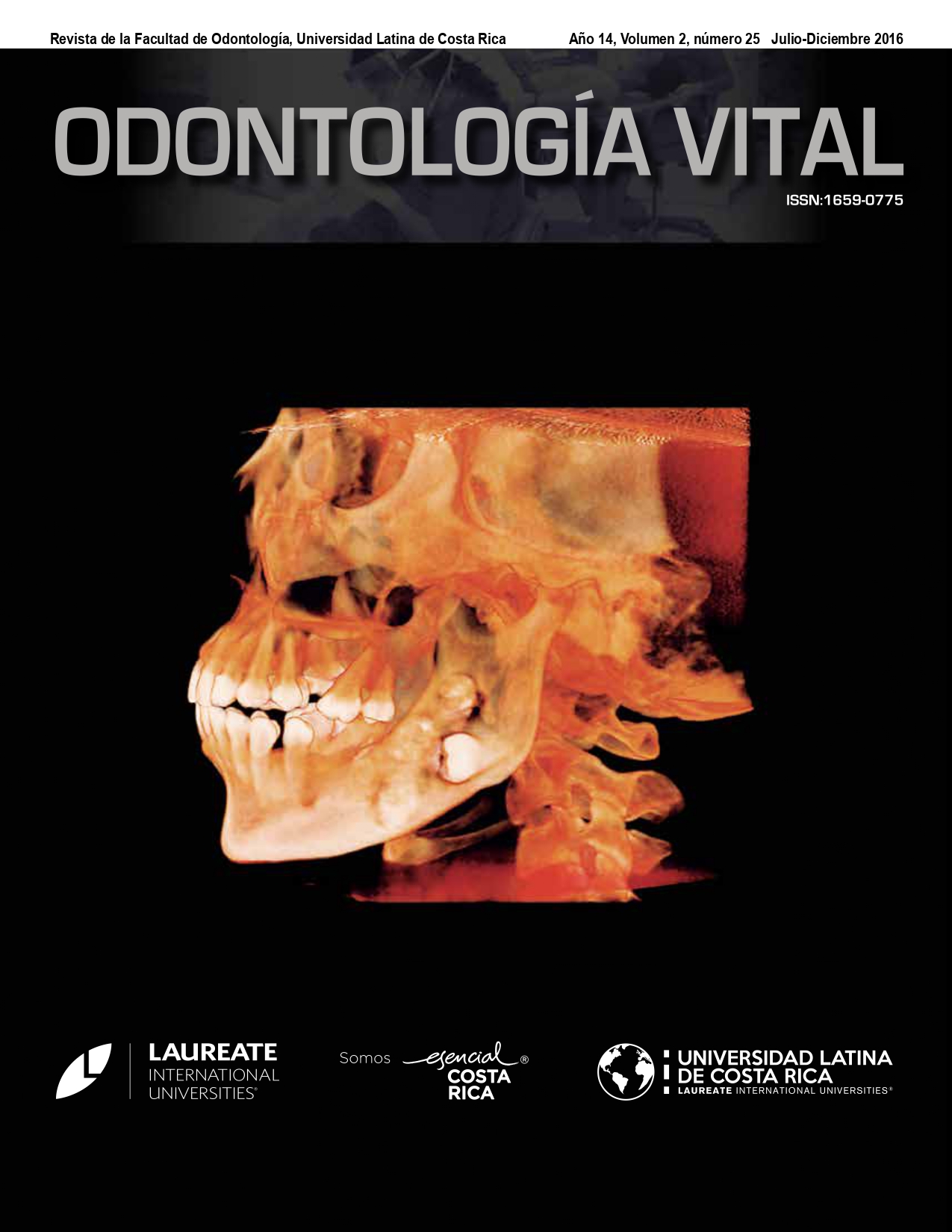Nanotechnology Sterilization in Dentistry
DOI:
https://doi.org/10.59334/ROV.v2i25.239Keywords:
Nanotechnology, nanodentistry, cold sterilizing, Nbelyax, ÉviterAbstract
Purpose: The goal of this research was to evaluate the effectiveness of the active Nbelyax cold sterilant (Éviter™) with nanotechnology in three different bacterial strains of great importance in dentistry: E. faecalis, S. aureus and Neisseria sp. Materials and
Method: An experimental, observational and qualitative study using three different bacterial strains was performed. The sterilant product was prepared at 1: 20 dilution. Then, in a 250 mL Erlenmeyer flask were poured 99 mL of the sterilant prepared, each bacterial strain was inoculated in same flask, allowing two different contact times: 5 and 30 minutes. Subsequently, an aliquot of 0.1 mL in 18 mL of trypticase soy per petri plaque was done using pour plate technique and incubated 48 hours at 37 °C. The experiment was done by duplicate. The SPSS statistical program version 20.0 was used, applying Mcnemar statistical test to analyze the results.
Results: This research showed that after 5 minutes of contact with the cold sterilant Éviter, E. faecalis and S. aureus strains had bacterial growth, however Neisseria sp. did not have bacterial colonies growth. The three bacterial strains after 30 minutes of contact did not show colonies growth. McNemar test did not show significant statistical differences (p≥0.05).
Conclusions: With the sample and ramimethodology used, we observed that the recommended contact time of the cold sterilant Éviter product with nanotechnology to eliminate the microorganism tasted was 30 minutes.
Downloads
References
Velázquez AM. (2011) Una revolución en miniatura: Nanotecnología al servicio de la humanidad. España: Universitat de València; pp. 176.
Poole CP, Owens FJ. (2007) Introducción a la nanotecnología. España: Editorial Reverte; pp. 417.
Lechuga LM. (2010) Nanomedicina: aplicación de la nanotecnología en la salud. Biotecnología aplicada a la salud humana; Noviembre; 9: 98-112.
Nagpal Archna, Kaur Jasjeet, Sharma Suchita, Bansal Arti, Sachdev Priyanka; (2011) Nanotechnology – the era of molecular dentistry; Indian Journal of Dental Science; December; 3(5).
Dwivedi S, Dwivedi CD, Chandra A, Sharma N. (2013) Nanotechnology boon or bane for restorative dentistry; A review. International Journal of Engineering Science Invention; 2: 01-05. https://doi.org/10.4103/2278-9626.106827
Martínez HR, Abdala HM, Treviño E,Garza G, Pozas A, Rivera G. (2011) Application of nanotechnology in dentistry: Nano-Dentistry. Rev.CES Odont; 24(2), 87-91.
Neetha J. Shetty, P. Swati, K. David. (2013) Nanorobots: Future in dentistry. The Saudi Dental Journal; 25: 49–52. Abiodun-Solanke IMF, Ajayi DM, Arigbede AO. (2014) Nanotechnology and its aplication in dentistry. Annals of Medical Health & Sciences Research; 4: 171–177. https://doi.org/10.4103/2141-9248.141951
Kumar SR, Vijayalakshmi R. (2006) Nanotechnology in dentistry. Indian J. Dent. Res., 17 pp. 62–69. https://doi.org/10.4103/0970-9290.29890
Robert A, Freitas JR. (2010) Nanodentistry: Cover Story. JADA; 131:1559-1565. https://doi.org/10.14219/jada.archive.2000.0084
http://www.hospitalneuquen.org.ar/wp-content/uploads/06/HIGIENE_HOSPITALARIA_actualizada1.pdf
http://www.ucv.ve/fileadmin/user_upload/facultad_farmacia/catedraMicro/08_Tema_14_Limpieza__ desinfecci%C3%B3n.pdf
Vignoli R. Esterilización, desinfección y antisepsia. Temas de bacteriología y virología médica. 2ª ed. Uruguay: Ed. Montevideo. Oficina del libro FEFMUR; Vol. 1, pp. 609-629.
http://bmeditores.mx/wp-content/uploads/2015/04/avicultores-104.pdf
Khan AA, Javed O, Khan M, Mehboob B, Baig S. (2012) Cross infection control. Pakistan Oral and Dental Journal. Apr; 32:31.
Ganavadiya R, Chandra Shekar BR, Saxena V, Tomar P, Gupta R, Khandelwal G. (2014) Disinfecting efficacy of three chemical disinfectants on contamined diagnostic instruments: A randomized trial. J Basic Clin Pharma; 5: 98-104. https://doi.org/10.4103/0976-0105.141946
Orsi IA, Junior AG, Villabona CA, Fernandes FHCN, Ito IY. (2011) Evaluation of the efficacy of chemical disinfectants for disinfection of heat-polymerised acrylic resin. Gerodontology; 28: 253-257. https://doi.org/10.1111/j.1741-2358.2010.00400.x
Özalp N, Ökte Z, Özcelik B. (2006) The Rapid Sterilization of Gutta-Percha Cones with Sodium Hypochlorite and Glutaraldehyde. Journal of Endodontics; 32: 1202–1204. https://doi.org/10.1016/j.joen.2006.08.009
Erin L. Gross, Eugene J. Leys, Stephen R. Gasparovich, Noah D. Firestone, et al. (2010) Bacterial 16S Sequence Analysis of Severe Caries in Young Permanent Teeth. J Clin Microbiol. Nov; 48(11): 4121–4128.
Saunders KA, Greenman J, McKenzie C. J. (2000) Ecological effects of triclosan and triclosan monophosphate on defined mixed cultures of oral species grown in continuous culture. Antimicrob Chemother. Apr; 45(4): 447-52.
Downloads
Published
Issue
Section
License
Copyright (c) 2016 Uriel David Castro Balleza, María Guadalupe Flores Luna, Javier García Hernández, Sandra Laura Alavez Rebollo

This work is licensed under a Creative Commons Attribution 4.0 International License.
Authors who publish with Odontología Vital agree to the following terms:
- Authors retain the copyright and grant Universidad Latina de Costa Rica the right of first publication, with the work simultaneously licensed under a Creative Commons Attribution 4.0 International license (CC BY 4.0) that allows others to share the work with an acknowledgement of the work's authorship and initial publication in this journal.
- Authors are able to enter into separate, additional contractual arrangements for the non-exclusive distribution of the Odontología Vital's published version of the work (e.g., post it to an institutional repository or publish it in a book), with an acknowledgement of its initial publication.
- Authors are permitted and encouraged to post their work online (e.g., in institutional repositories or on their website) prior to and during the submission process, as it can lead to productive exchanges, as well as earlier and greater citation of published work.







